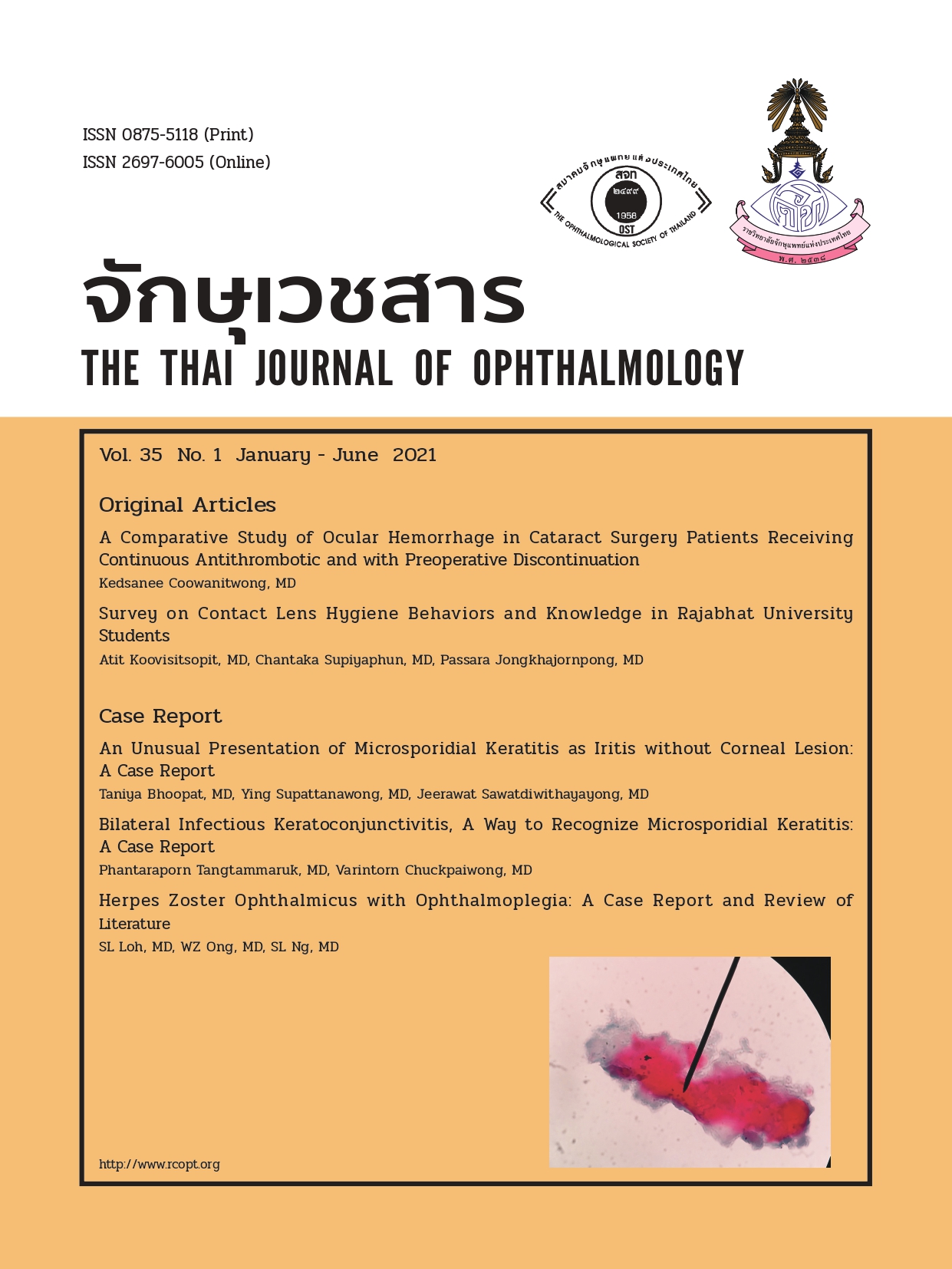การสำรวจความรู้และพฤติกรรมการใช้เลนส์สัมผัสในนักศึกษามหาวิทยาลัยราชภัฏสวนสุนันทา
คำสำคัญ:
เลนส์สัมผัส, พฤติกรรม,ความรู้ , นักศึกษามหาวิทยาลัยบทคัดย่อ
วัตถุประสงค์: เพื่อศึกษาสุขอนามัยและระดับความรู้เกี่ยวกับการใช้เลนส์สัมผัสในกลุ่มนักศึกษามหาวิทยาลัยราชภัฏและศึกษาความสัมพันธ์ระหว่างพฤติกรรมเสี่ยงในการใช้เลนส์สัมผัสที่สัมพันธ์กับการเกิดภาวะแทรกซ้อนจากการใส่เลนส์สัมผัส
วิธีการวิจัย: ผู้วิจัยได้ทำการสำรวจในนักศึกษามหาวิทยาลัยราชภัฏสวนสุนันทาระหว่าง เดือนกรกฎาคมถึงเดือนกันยายน พ.ศ. 2562 อาสาสมัครผู้เข้าร่วมงานวิจัยจะต้องเป็นผู้ที่ใส่เลนส์สัมผัส และสามารถตอบแบบสอบถามออนไลน์เกี่ยวกับความรู้และสุขอนามัยในการใส่เลนส์สัมผัสได้สมบูรณ์ ข้อมูลที่ได้ถูกมาวิเคราะห์โดยใช้สถิติเชิงพรรณนา และใช้ Chi-square หรือ Fisher's Exact Test และ logistic regression เพื่อหาความสัมพันธ์ระหว่างพฤติกรรมการใช้เลนส์สัมผัสที่เสี่ยงต่อการเกิดภาวะแทรกซ้อนจากการใส่เลนส์สัมผัส
ผลการวิจัย: จากอาสาสมัครที่ร่วมตอบแบบสอบถามทั้งหมด 369 คน พบว่ามีนักเรียนจำนวน 255 (69.1%) คนที่ปัจจุบันใส่เลนส์สัมผัสอยู่และถูกข้อมูลนำมาวิเคราะห์ นักเรียนมีอายุเฉลี่ย 18.8 ปี ส่วนใหญ่เป็นผู้หญิง (83.9%) 90.5% ของนักเรียนทั้งหมดใส่เลนส์สัมผัสชนิดนิ่มรายเดือน 62.2% ของนักเรียนทั้งหมดมีพฤติกรรมการใช้เลนส์สัมผัสในระดับดี ขณะที่มีนักเรียนเพียง 41.3% ที่มีความรู้เกี่ยวกับสุขอนามัยของการใช้เลนส์สัมผัสในระดับดี มีนักเรียนจำนวน 79 คน (31%) ที่มีพฤติกรรมการใส่เลนส์สัมผัสขณะว่ายน้ำ และมีนักเรียนจำนวน 29 คน (11.3%) ที่ให้ประวัติเคยเป็นกระจกตาอักเสบจากการใส่เลนส์สัมผัส นอกจากนี้ยังพบว่าการใส่เลนส์สัมผัสขณะว่ายน้ำมีความสัมพันธ์กับประวัติการเป็นกระจกตาอักเสบจากการใส่เลนส์สัมผัสอย่างมีนัยสำคัญที่ P = 0.01 (อัตราส่วนออด = 2.7)
สรุปผลการวิจัย: ผลงานวิจัยชี้ให้เห็นว่า นักศึกษามหาวิทยาลัยราชภัฏยังมีความรู้และสุขอนามัยเกี่ยวกับการใช้เลนส์สัมผัสที่ไม่เพียงพอ และจำเป็นอย่างยิ่งที่จะต้องมีการรณรงค์เพื่อให้นักเรียนได้มีความรู้ความเข้าใจที่ถูกต้อง รวมถึงการสร้างความตระหนักถึงภาวะแทรกซ้อนที่สามารถเกิดได้จากพฤติกรรมเสี่ยงในการใช้เลนส์สัมผัส โดยเฉพาะการใส่เลนส์สัมผัสขณะว่ายน้ำซึ่งสัมพันธ์อย่างมีนัยสำคัญกับการเกิดกระจกตาอักเสบจากการใส่เลนส์สัมผัส
เอกสารอ้างอิง
Sankaridurg P. Contact lenses to slow progression of myopia. Clin Exp Optom. 2017 Sep;100(5):432-7.
Rathi VM, Mandathara PS, Dumpati S. Contact lens in keratoconus. Indian J Ophthalmol. 2013 Aug;61(8):410-5.
Lim, Chris, Stapleton, Fiona, Mehta, Jodhbir. Review of Contact Lens–Related Complications, Eye & Contact Lens: Science & Clinical Practice: November 2018;44:S1-10.
Uchino M, Dogru M, Uchino Y, et al. Japan Ministry of Health study on prevalence of dry eye disease among
Japanese high school students. Am J Ophthalmol. 2008 Dec;146(6):925-9.e2.
Cope JR, Collier SA, Rao MM, et al. Contact Lens Wearer Demographics and Risk Behaviors for Contact Lens-Related Eye Infections--United States, 2014. MMWR Morb Mortal Wkly Rep. 2015 Aug 21;64(32):865-70.
Cope JR, Collier SA, Nethercut H, et al. Risk Behaviors for Contact Lens-Related Eye Infections Among Adults and Adolescents - United States, 2016. MMWR Morb Mortal Wkly Rep. 2017 Aug 18;66(32):841-5.
Li W, Sun X, Wang Z, et al. A survey of contact lensrelated complications in a tertiary hospital in China. Cont Lens Anterior Eye. 2018 Apr;41(2):201-4.
Abbouda A, Restivo L, Bruscolini A, et al. Contact Lens Care among Teenage Students in Italy: A Cross- Sectional Study. Semin Ophthalmol. 2016;31(3):226- 32.
Zhu Q, Yang B, Deng N, et al. The use of contact lenses among university students in Chengdu: Knowledge and
practice of contact lens wearers. Cont Lens Anterior Eye. 2018 Apr;41(2):229-33.
Mohd-Ali B, Tan XL. Patterns of Use and Knowledge about Contact Lens Wear amongst Teenagers in Rural
Areas in Malaysia. Int J Environ Res Public Health. 2019 Dec 17;16(24):5161.
Bakkar MM, Alzghoul EA. Assessment of compliance with contact lens wear and care among university-based
population in Jordan. Cont Lens Anterior Eye. 2020 Aug;43(4):395-401.
Wongkrajang P, Neeser KJ. Knowledge, Attitude, Practice and Eye Problems from Contact Lens Use in
Students at Chulalongkorn University 2010, J Health Res. 2010;26(3):113-8.
Supinda Leeamornsiri, Yothin Titawattanakul, Comparative Knowledge and Behavior of Contact Lens
Care between Medical and Non-Medical Students, J Med Assoc Thai. 2015;98(Suppl 3):S23.
Luksanaporn Krungkraipetch, Knokwan Wongsuwan, Knowledge, Attitude and Behavior Toward Utilization
of Contact Lens Among First Year Students in Burapha University,Burapha jourmal of medicine. 2015;2(2).
Chantaka Supiyaphun, Puncharut Preechaharn, Knowledge and Behavior of Contact Lens Wear in
Medical Students and Medical Residents in Vajira Hospital, Vajira Med J. 2020; 64(4):275-86.
Blümle S, Kaercher T, Khaireddin R. Richtige Kontaktlinsenhygiene [Correct contact lens hygiene]. Ophthalmologe. 2013 Jun;110(6):522-7. German.
Jun J, Zhiwen B, Feifu W, et al. Fan, Level of compliance in Orthokeratology. Eye Contact Lens. (2018;44:330-4.
Arshad M, Carnt N, Tan J, Ekkeshis I, Stapleton F. Water Exposure and the Risk of Contact Lens-Related
Disease. Cornea. 2019 Jun;38(6):791-7.
R. Gyawali, F. Nestha,Mohamed, et al., Compliance and hygiene behaviour among soft contact lens wearers
in the Maldives. Clin Exp Optom. 2014;97:43-47.
ดาวน์โหลด
เผยแพร่แล้ว
ฉบับ
ประเภทบทความ
สัญญาอนุญาต
The Thai Journal of Ophthalmology (TJO) is a peer-reviewed, scientific journal published biannually for the Royal College of Ophthalmologists of Thailand. The objectives of the journal is to provide up to date scientific knowledge in the field of ophthalmology, provide ophthalmologists with continuing education, promote cooperation, and sharing of opinion among readers.
The copyright of the published article belongs to the Thai Journal of Ophthalmology. However the content, ideas and the opinions in the article are from the author(s). The editorial board does not have to agree with the authors’ ideas and opinions.
The authors or readers may contact the editorial board via email at admin@rcopt.org.


